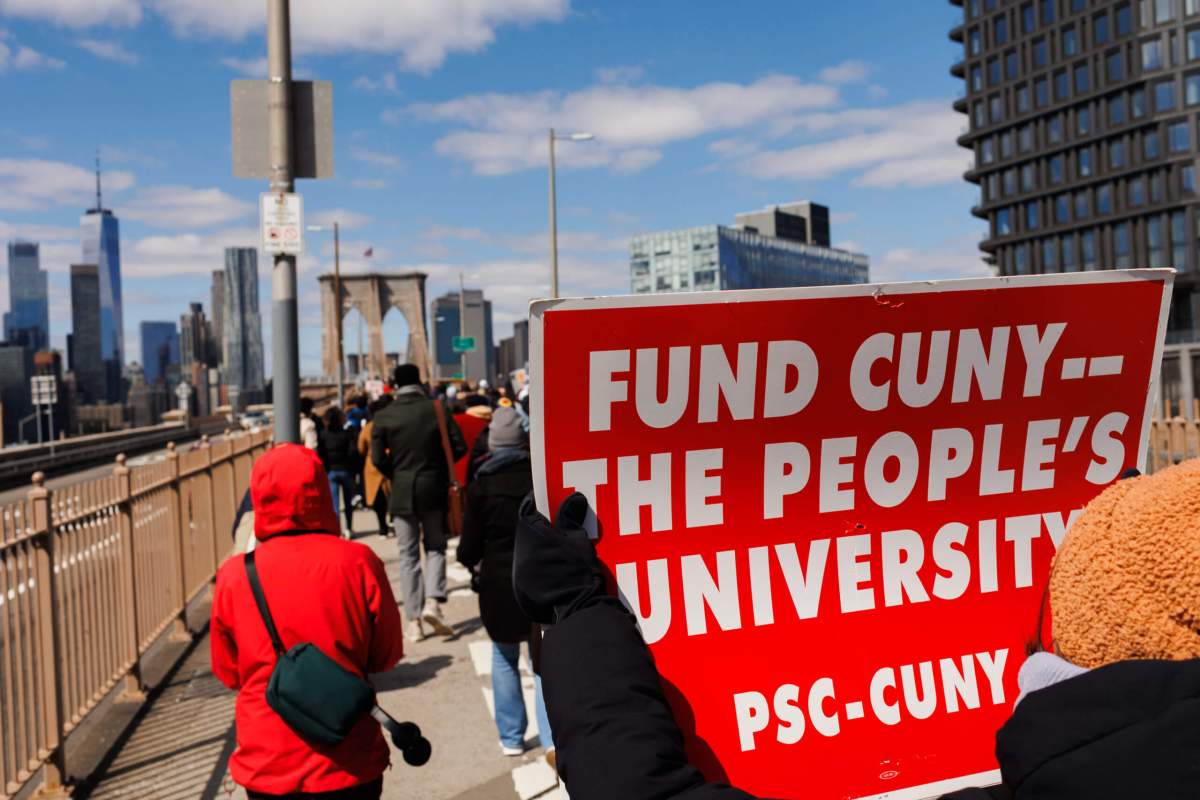We know CUNY and the Ivy League. Chloë holds degrees from Yale and Brooklyn College, Tom from Princeton and Hunter College. This semester, we are both teaching in the art department at Queens College. We understand this: the higher education system is not equitable. The Ivies are raking in donations while CUNY is facing big cuts.
Queens College has a lovely campus, and good facilities. We have smart and committed colleagues. Our students are breathtakingly diverse – three out of four are people of color. In a world that routinely divides us by race, ethnicity, class, and other identity markers, our amazing students take multifaceted diversity for granted. If you are worried about our increasingly segregated city, come visit our classes at CUNY. Though many students are low-income (one third of CUNY undergraduates come from households earning less than $20,000 a year), our students are not going into debt – that great disgrace of American higher education. Only 14% of Queens College students take out student loans, and even those students carry relatively light debt burdens.
And there are some things CUNY is exceptionally good at, far outperforming the Ivy League. Overall, CUNY propels almost six times as many low-income students into the middle class as the Ivy universities combined. Using Brookings Institute’s “bottom-to-top” mobility scale, Brooklyn College ranks #9 in the nation, Hunter College #12, Queens College #14. Meanwhile our Alma Maters? Yale ranks #335, Princeton an abysmal #714. We’re not saying that Queens College is a “better school” than Yale and Princeton. Maybe or maybe not. It depends on what you value, both in your own individual life, and for a larger society.
Quite honestly, teaching at Queens College can be a bit more complex than teaching at a well-resourced private college. The challenges our students face – economic, family and caregiving needs, jobs, even commuting – are far greater. In a theoretical world that values equitable outcomes, we would have small classes at Queens College, on par with the Ivy League. But the student-teacher ratio at Queens College is three times that of Yale and Princeton. Meanwhile, CUNY is seriously understaffed for career counseling that could lead to paid internships and post-graduation jobs. How dire is it? A Center for an Urban Future report found most CUNY colleges have two or three career counselors per 10,000 students. When tenured colleagues leave, their lines are often not replaced. This means there are fewer full-time colleagues to take on significant administrative and departmental needs. This spring, nervous emails are rattling through our inboxes, warning us to prepare to implement cuts (up to 20% of our budget!) which could exacerbate an already stretched situation.
What is clear is that our system funnels money to elite private universities, not public ones like CUNY. When Princeton received a $101 million donation for the arts from Peter Lewis, or Yale received $150 million from David Geffen for the theater program (not to mention $300 million from Ken Griffin for Harvard’s Faculty of Arts and Sciences) it meant great facilities, well-resourced faculty, and low tuition. But let’s not forget that these contributions were tax deductible. The hundreds of millions in forgone taxes on these gifts were an enormous public sector contribution to the richest institutions in the country. Queens College recently celebrated its largest-ever gift to the visual arts, $1.1 million from the arts-loving Queens businessman, Thomas Chen. We are not against raising money from the private sector. We have each helped raise donations from the Mellon and Rockefeller Foundations to support CUNY programs. But until things change radically, this private foundation money needs to be the icing on the cake. For example, Tom helped launch CUNY Cultural Corps when he was Commissioner of Cultural Affairs of NYC, a public-and-privately funded program that has placed over a thousand CUNY students in paid internships at hundreds of cultural organizations across the city over the last seven years. It’s a great program – but it only works if the overall CUNY budget is healthy.
CUNY is a national treasure that is already underfunded. We need larger budgets to realize the amazing potential of the university: better paid faculty with sane workloads, more staff, less reliance on adjunct professors, more counseling for students. Mayor Eric Adams and 19 City Council members went to CUNY. They need to start by restoring the proposed $50 million baseline cut to CUNY in the city’s FY 2024 budget. Then we need to expand CUNY’s budget to make this remarkable institution all it can be. Can it continue to claim the mantle “Harvard of the working class?” Maybe, but only if we rally to support its funding.
Chloë Bass is the Co-Director of Social Practice CUNY. Tom Finkelpearl is the former Commissioner of Cultural Affairs of New York City.
Read more: NYC Crime Rates Continue to Decline in 2023




































